Russian aircraft carrier Admiral Kuznetsov
 | |
| Career (Soviet Union ⁄ Russia) | |
|---|---|
| Name: | Admiral of the Fleet of the Soviet Union Kuznetsov (Russian: Адмира́л Фло́та Сове́тского Сою́за Кузнецо́в) |
| Namesake: | Nikolay Gerasimovich Kuznetsov |
| Ordered: | 3 March 1981 |
| Builder: |
Nikolayev South Designer: Nevskoye Planning and Design Bureau |
| Laid down: | 1 April 1982 [1] |
| Launched: | 6 December 1985 [1] |
| Commissioned: |
25 December 1990[1] Fully operational in 1995 |
| Status: | Ship in active service, refit planned during 2014 or after |
| General characteristics | |
| Class and type: | Admiral of the Fleet of the Soviet Union Kuznetsov-class aircraft carrier |
| Displacement: | 43,000 tons (Standard-load)[1] 55,200 tons (Full-load)[1] 61,390 tons (Max-load) |
| Length: | 305 m (1,001 ft) o/a[1] 270 m (890 ft) w/l |
| Beam: | 72 m (236 ft)[1] o/a 35 m (115 ft) w/l[1] |
| Draft: | 10 m (33 ft)[1] |
| Propulsion: | Steam turbines, 8 turbo-pressurised boilers, 4 shafts, 200,000 hp (150 MW) 2 × 50,000 hp (37 MW) turbines 9 × 2,011 hp (1,500 kW) turbogenerators 6 × 2,011 hp (1,500 kW) diesel generators 4 × fixed pitch propellers |
| Speed: | 29 knots (33 mph; 54 km/h)[1] |
| Range: | 8,500 nmi (15,700 km) at 18 kn (21 mph; 33 km/h)[1] |
| Endurance: | 45 days[1] |
| Complement: | 1,690 (total); 1,690 ship's crew[1] 626 air group 40 flag staff 3,857 rooms |
| Armament: | • 8 × AK-630 AA guns (6×30 mm, 6,000 round/min/mount, 24,000 rounds) • 8 × CADS-N-1 Kashtan CIWS (each 2 × 30 mm Gatling AA plus 32 3K87 Kortik SAM) • 12 × P-700 Granit SSM • 24 × 8-cell 3K95 Kinzhal SAM VLS (192 missiles; 1 missile per 3 seconds) • RBU-12000 UDAV-1 ASW rocket launchers (60 rockets) |
| Aircraft carried: | 41–52[2]
|
Admiral Flota Sovetskovo Soyuza Kuznetsov (Russian: Адмира́л фло́та Сове́тского Сою́за Кузнецо́в "Admiral of the Fleet of the Soviet Union Kuznetsov") was built by the Black Sea Shipyard, the sole manufacturer of Soviet aircraft carriers, in Mykolaiv within the Ukrainian Soviet Socialist Republic. The initial name of the ship was Riga; she was launched as Leonid Brezhnev, embarked on sea trials as Tbilisi, and finally named Kuznetsov.[4] She is an aircraft cruiser (heavy aircraft-carrying missile cruiser (TAVKR) in Russian classification) serving as the flagship of the Russian Navy.
She was originally commissioned in the Soviet Navy, and was intended to be the lead ship of her class, but the only other ship of her class, Varyag, was never completed or commissioned by the Soviet, Russian or Ukrainian navy. Later, this second hull was sold to the People's Republic of China by Ukraine, completed in Dalian and launched as Liaoning.[5] Kuznetsov was named after the Admiral of the Fleet of the Soviet Union Nikolay Gerasimovich Kuznetsov.
Role
While designated an aircraft carrier by the West, the design of the Admiral Kuznetsov-class implies a mission different from that of either the United States Navy’s carriers or those of the Royal Navy. The term used by her builders to describe the Russian ships is tyazholyy avianesushchiy raketnyy kreyser (TAVKR or TARKR) – "heavy aircraft-carrying missile cruiser" – intended to support and defend strategic missile-carrying submarines, surface ships, and naval missile-carrying aircraft of the Russian Navy.

Admiral Kuznetsov's main fixed-wing aircraft is the multi-role Sukhoi Su-33. It can perform air superiority, fleet defence, and air support missions and can also be used for direct fire support of amphibious assault, reconnaissance and placement of naval mines.[6]
The carrier also carries the Kamov Ka-27 and Kamov Ka-27S helicopters for anti-submarine warfare, search and rescue, and small transport.
For take-off of fixed wing aircraft, Admiral Kuznetsov uses a ski-jump at the end of her deck. On take-off aircraft accelerate toward and up the ski-jump using their afterburners. This results in the aircraft leaving the deck at a higher angle and elevation than on an aircraft carrier with a flat deck and catapults. The ski-jump take-off is less demanding on the pilot, since the acceleration is lower, but results in a clearance speed of only 120–140 km/h (75–85 mph) requiring an aircraft design which will not stall at those speeds.[7]
The cruiser role is facilitated by Kuznetsov's complement of 12 long-range surface-to-surface anti-ship Granit (SS-N-19) (NATO name Shipwreck) cruise missiles. This armament justifies the ship's Russian type designator "heavy aircraft-carrying missile cruiser".
History
Admiral Flota Sovetskovo Soyuza Kuznetsov, constructed at Nikolayev South Shipyard in Mykolaiv, Ukrainian SSR, was launched in 1985, and became fully operational in 1995. An official ceremony marking the start of construction took place on 1 September 1982; in fact she was laid down in 1983. The vessel was first named Riga, then the name was changed to Leonid Brezhnev, this was followed by Tbilisi. Finally, on 4 October 1990,[8] she was renamed Admiral Flota Sovetskovo Soyuza Kuznetsov, referred to in short as Admiral Kuznetsov.[4] The ship was 71% complete by mid-1989. In November 1989 she undertook her first aircraft operation trials. In December 1991, she sailed from the Black Sea to join the Northern Fleet. Only from 1993 on did she receive aircraft.
1995–96 Mediterranean Deployment
From 23 December 1995 through 22 March 1996 Kuznetsov made its first 90-day Mediterranean deployment with 13 Su-33, 2 Su-25 UTG, and 11 helicopters aboard.[9] This cruise marked the 300th anniversary of the Russian Navy celebrated in 1996. During that period the carrier lay at anchor at sea off the port of Tartus, Syria.[10] While in the Mediterranean her aircraft, mainly Su-33 fighters, made flights close to the Israeli shore line and were intercepted by Israeli F-16s.[10]
1997–98
At the end of 1997 she remained immobilized in a Northern Fleet shipyard, awaiting funding for major repairs, which were halted when they were only 20% complete. The overhaul was completed in July 1998, and the ship returned to active service in the Northern fleet on 3 November 1998.
2000
Kuznetsov apparently remained in port for about two years before preparing for another Mediterranean deployment scheduled for the winter of 2000–2001. This deployment was cancelled due to the loss of the nuclear-powered submarine Kursk. The Kuznetsov participated in operations related to the rescue and salvage of the Kursk submarine in late 2000. Plans for further operations were postponed or cancelled.
2003–04
In late 2003 and early 2004, Kuznetsov went to sea for inspection and trials. In late October 2004, she participated in a fleet exercise of the Russian Navy in the Atlantic Ocean,[11] and again in September 2005. During the 2005 exercise, one of her Su-33 fighters was involved in an accident, and fell from the carrier into the Atlantic Ocean.
2006
On 27 September 2006 it was announced that Admiral Kuznetsov will return to service in the Northern Fleet by the end of the year. The ship will undergo another modernization refit, in an attempt to correct some of her many technical issues. Admiral Vladimir Masorin, Commander-in-Chief of the Russian Navy, also stated that several Su-33 fighters assigned to the aircraft carrier would return to the ship after undergoing maintenance and refits of their own.
2007–08 Mediterranean deployment
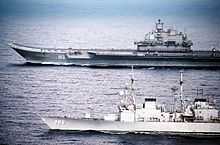
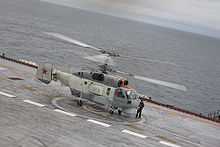
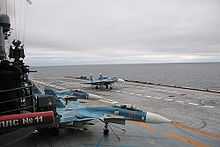
From 5 December 2007 through 3 February 2008 Kuznetsov made its second Mediterranean deployment.[9] On 11 December 2007, Admiral Kuznetsov passed by Norwegian oil platforms in the North Sea, 60 nautical miles (110 km) outside Bergen, Norway.[12] Su-33 fighters and Kamov helicopters were launched from the carrier while she was in the area of the rigs. The incident caused the Norwegian helicopter service to stop its flights out to the rigs, due to a risk of collision with Russian aircraft operating from the carrier. The Russian carrier was in international waters during the maneuver.
Admiral Kuznetsov then proceeded to the Mediterranean Sea, where she participated in an exercise together with 11 other Russian Navy surface ships and 47 aircraft. She performed three tactical training missions, using live and simulated missile launches with both air and surface missiles.[13]
The aircraft carrier arrived back in Severomorsk on 3 February 2008 along with the Udaloy II class destroyer Admiral Chabanenko and Udaloy I class ASW Destroyer Admiral Levchenko.
After a maintenance period she was back at sea on 11 October 2008 where drills were held in the Barents Sea. Russian President and Supreme Commander-in-Chief Dmitry Medvedev visited the ship on 12 October 2008 during the Stability-2008 strategic exercises.
2008–09 Mediterranean deployment
From 5 December 2008 through 2 March 2009 Kuznetsov made its third Mediterranean deployment.[9]
On 5 December 2008 the aircraft carrier and several other vessels left Severomorsk heading for the Atlantic on a tour which was announced would be lasting several months and which would include combat training including joint drills with Russia's Black Sea Fleet and visits to several ports in the Mediterranean.[14][15] On this tour while the Admiral Kuznetsov anchored off Turkey on 7 January 2009 a small fire broke out on the ship. One crew member was killed by carbon monoxide poisoning. The fire was caused by a short-circuit.[16]
On 16 February 2009, Admiral Kuznetsov, along with other Russian naval vessels was involved in a large oil spill while she refuelled off the south coast of Ireland.[17]
On 2 March 2009 Admiral Kuznetsov returned to her main base in Severomorsk after a three-month voyage in the Northern Atlantic and the Mediterranean waters.
2010
In September 2010 Admiral Kuznetsov left a dry dock after scheduled repairs and is getting ready for a training mission in the Barents Sea at the end of that month.
2011–12 Mediterranean deployment
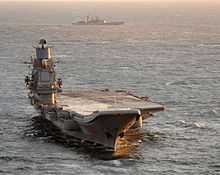
The Russian Main Navy Staff announced that Kuznetsov will begin a deployment to the Atlantic and Mediterranean in the early days of December. The carrier will be escorted by the large ASW ship Admiral Chabanenko. In late November 2011, Pravda and Reuters announced that a squadron led by the Admiral Kuznetsov will deploy to its naval facility in Tartus as a show of support for the al-Assad regime.[18][19] However, in contradiction a Russian naval spokesman stated to the Izvestia daily that "The call of the Russian ships in Tartus should not be seen as a gesture towards what is going on in Syria," and "This was planned already in 2010 when there were no such events there. There has been active preparation and there is no need to cancel this," noting that Admiral Kuznetsov would also be making port calls in Beirut, Genoa and Cyprus.[20]
On 29 November 2011, Army General Nikolay Makarov, Chief of the Russian General Staff, said that sending ships of the Russian Navy to the Mediterranean Sea is linked to exercises and not to the situation in Syria. "In the event of necessity, namely to carry out repairs, to take water and food on board and to allow rest for the crews, Russian ships may visit Tartus but in this case this has not been included in the plan of the trip," the Interfax source said. He also noted that the size of Admiral Kuznetsov does not allow it to moor in Tartus because the port does not have suitable infrastructure, i.e. large enough mooring.[21]
On 6 December 2011, Admiral Kuznetsov and escorting ships departed its Northern Fleet homebase for a several month Mediterranean deployment. During the deployment Kuznetsov will also exercise with ships from the Russian Baltic and Black Sea Fleets.[22]
On 12 December 2011 Admiral Kuznetsov with its carrier group, has been spotted northeast of the Orkneys off the coast of northern Scotland from where it has been shadowed by HMS York for a week. This was the first time the carrier had deployed near the UK; due to severe weather, the group took shelter in international waters in the Moray Firth, some 30 miles from the UK coast. The Kuznetsov then sailed around the top of Scotland and into the Atlantic past western Ireland, where it conducted flying operations with her Sukhoi Su-33 Flanker jets and Kamov Ka-27 helicopters in international airspace.[23]
On 8 January 2012, Admiral Kuznetsov anchored near shore outside Tartus while other ships in its escort entered the port to use the leased Russian naval support facility. After replenishing supplies, all of the ships will continue their Mediterranean deployment on 9 January.[24]
On 17 February 2012, Admiral Kuznetsov returned to its homebase of Severomorsk.
2013-14 Deployment

On 1 June 2013, it was announced that the ship would return to the Mediterranean by the end of the year.[25] On 17 December, Kuznetsov departed its homebase for the Mediterranean Sea and will not return earlier than May 2014.[26] On 1 January 2014, Kuznetsov celebrated New Year while at anchor in international waters of the Moray Firth off northeast Scotland. The anchorage allowed replenishment of ship's supplies and respite for the crew from stormy weather off the southwest coast of Norway. She then proceeded to the Mediterranean Sea,[27] docking in Cyprus on 28 February.[28]
In May 2014, the ship and its task group: the Kirov Class nuclear powered cruiser Petr Velikiy; three tankers; Sergey Osipov, Kama and Dubna; one Ocean-going Tug Altay and the Tank Landing Ship Minsk (a Ropucha-class landing ship part of the Baltic Fleet?) sailed home and approached the UK.[29]
Although financial and technical problems have resulted in limited operations for the ship,[30] it is expected that Admiral Kuznetsov will remain in active duty until at least 2030.[31]
MiG-29K for the Admiral Kuznetsov
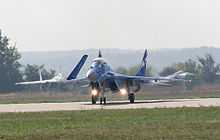
According to the newspaper "Bulletin Reports," the Russian Navy expects to buy the Mikoyan MiG-29K for Admiral Kuznetsov by 2011, according to an informed source in the Russian Ministry of Defence, noting that the contract may be concluded in the next two years. Information was confirmed by the general designer of one of the defence enterprises, which produces sub-assemblies for these aircraft, while the MiG corporation refrained from comment.[32][33]
Currently, the Navy has a fleet of 19 carrier-based Su-33 fighters, a resource which will expire by 2015. The production of new Su-33 is possible, but not cost-effective for such small volumes. At the same time, the MiG-29K in this respect are more convenient, because the Indian Navy already operates 24 aircraft, and has ordered a total of 45. As noted by Konstantin Makienko, it lessens the series article cost and allows Russia to save on development. India has paid 730 million dollars for the development and delivery of 16 fighters, while the 24 planes for Russia's fleet would cost about $1 billion.[32]
Mid-life refit
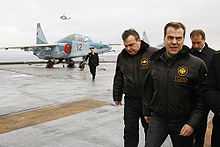
In April 2010 it was announced that by the end of 2012 the ship will enter Severodvinsk Sevmash shipyard for a major refit and modernisation.[34] The report states that the refit will include upgrades to the obsolete electronics and sensor equipment, installation of the new anti-aircraft system and increase of the air wing by the removal of the P-700 Granit anti-ship missiles. Upgrades might also include exchanging the troublesome steam powerplant to gas-turbine or even nuclear propulsion and installation of catapults to the angled deck.[34] As of December 2014 no such major refit has occurred.
See also
References
- ↑ 1.0 1.1 1.2 1.3 1.4 1.5 1.6 1.7 1.8 1.9 1.10 1.11 1.12 Yu.B. Apalkov, Korabli VMF SSSR, Tom 2, Udarnye Korabli, Galeya Print, Sankt Peterburg, 2003
- ↑ Admiral Kuznetsov the only aircraft carrier in the Russian Navy
- ↑ http://flotprom.ru/news/index.php?ELEMENT_ID=170929
- ↑ 4.0 4.1 Sovetskii Avianostsy, S.Balakin & V.Zablotskiy, Moscow 2007
- ↑ "China's Aircraft Carrier Ambitions: Seeking Truth from Rumors." Storey, I.; Ji, Y. Naval War College Review. Winter 2004, Vol. 57, No. 1.
- ↑ KnAAPO. "The Su-33 single-seat carrier-based fighter".
- ↑ Gordon, Yefim & Davidson, Peter. 2006. "Sukhoi Su-27 Flanker", p. 54. Warbird Tech Series, vol. 42. ISBN 978-1-58007-091-1.
- ↑ Korabli VMF SSSR" (USSR Navy Ships), Yu.V. Apalkov, Galeya Print, Sankt Peterburg, 2003
- ↑ 9.0 9.1 9.2 http://www.mil.ru
- ↑ 10.0 10.1 Encounters of the Russian Kind, IAF journal no. 145., June 2002 (Hebrew)
- ↑ Pavel Felgenhauer, A Foolhardy Naval Exercise, Moscow Times. Critical article about the Fall 2004 exercise in which Kuznetsov participated.
- ↑ Klungtveit, Harald S.; Gulseth, Hege Løvstad (11 December 2007). "Russiske jagerfly lager kaos i Nordsjøen" (in Norwegian). Retrieved 18 September 2008.
- ↑ Terje Solsvik; Wojciech Moskwa (11 December 2007). "Russian navy distrupts access to N.Sea oilfields". reuters.com. Retrieved 28 April 2012.
- ↑ "Russian warships head to Atlantic, Mediterranean". Moscow. AP. 5 December 2008. Retrieved 9 December 2008.
- ↑ "Russian naval task force heads to Atlantic, Mediterranean". Moscow. RIA Novosti. 5 December 2008. Retrieved 9 December 2008.
- ↑ Sailor killed in fire on board Russian warship off Turkey – 2 | Russia | RIA Novosti
- ↑ TimesOnline.co.uk Huge oil slick from Russian ship heads for British coastline, Accessed 17 February 2009.
- ↑ "Russia sent military ships to base in Syria". Hotspots and Incidents – Terrorism. Pravda. 30 November 2011. Retrieved 1 December 2011.
- ↑ Thomas Grove (28 November 2011). "Russia sending warships to its base in Syria". Africa. Rueters. Retrieved 1 December 2011.
- ↑ Russia to send warships to Syria in 2012: report
- ↑ Interfax, Moscow 1250 GMT 29 Nov 11
- ↑ RIA Novosti 6 Dec 2001 1121GMT
- ↑ "York completes a week shadowing Russia’s biggest warship around the British Isles" Royal Navy Press Release, 22 December 2011
- ↑ Russian news agency INTERFAX 8 January 2012
- ↑ "Admiral Kuznetsov aircraft carrier to start long-range mission in Mediterranean in late 2013". Russia Beyond The Headlines. 1 June 2013. Retrieved 2 June 2013.
- ↑ http://tvzvezda.ru/news/forces/content/201312171348-ad8c.htm
- ↑ Russia TV station ZVEZDA
- ↑ http://famagusta-gazette.com/russian-aircraft-carrier-docks-in-cyprus-p22487-69.htm
- ↑ http://www.royalnavy.mod.uk/News-and-Events/Latest-News/2014/May/08/140508-Russian-Task-Group
- ↑ "Advancing, blindly". The Economist. 18 September 2008. Retrieved 18 September 2008.
- ↑ Russia plans new life for naval assets Extract from Jane's, August 2006
- ↑ Trude Pettersen (25 September 2009). "New fighter jets for Admiral Kuznetsov". BarentsObserver.com. Archived from the original on 7 July 2011. Retrieved 28 April 2012.
- ↑ 34.0 34.1 "Moscow set to upgrade Admiral Kuznetsov aircraft carrier". RIA Novosti. 6 April 2010. Retrieved 7 April 2010.
External links
| Wikimedia Commons has media related to Admiral Kuznetsov. |
- Article on GlobalSecurity.org about the Kreml-class aircraft carrier.
- SU-25 at Faqs.org
- Video clip of Su-33 operating on the deck of Kuznetsov
- RIA Novosti article on the Kuznetsov rejoining the Northern Fleet
| ||||||||||||||||||